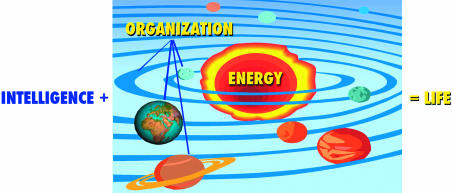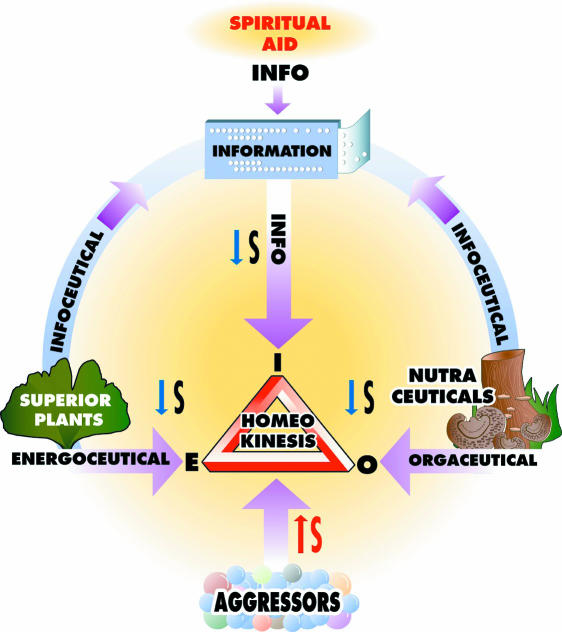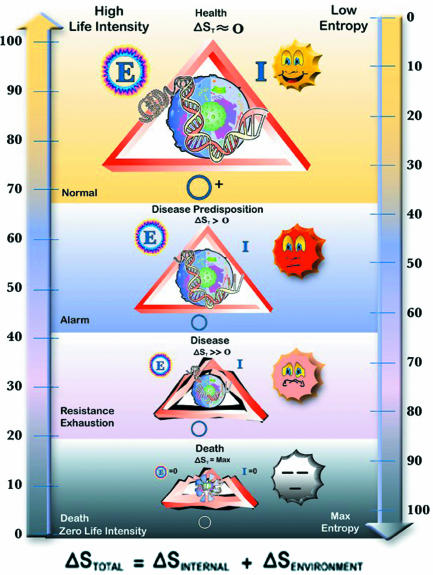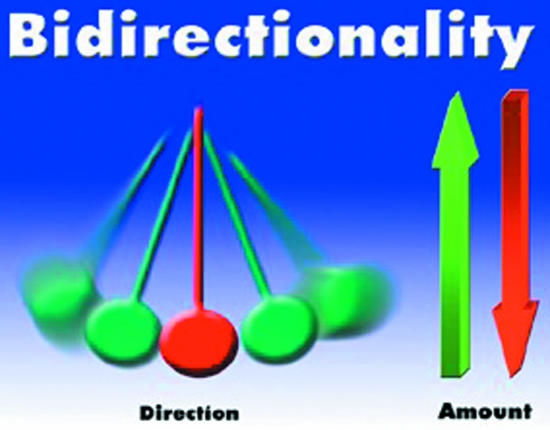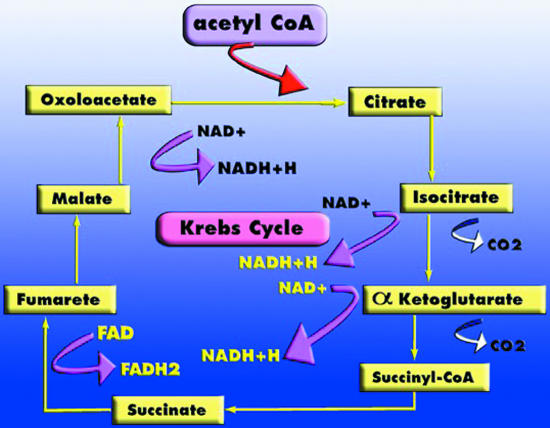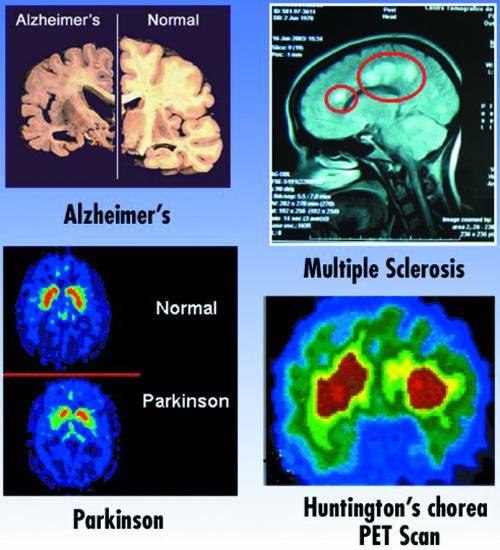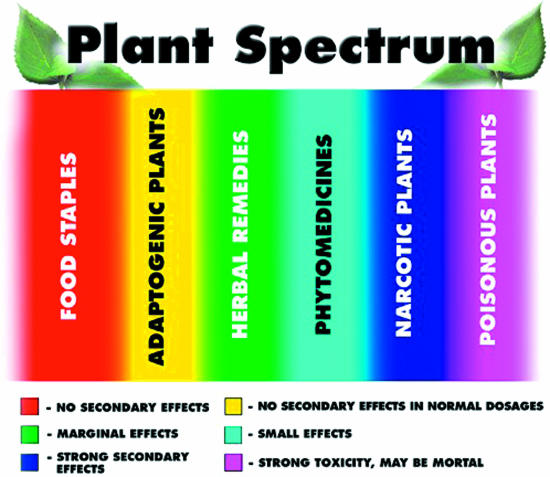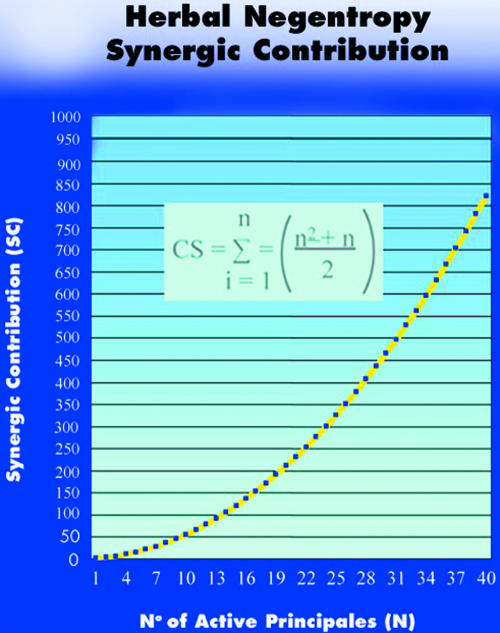Abstract
Western medical science lacks a solid philosophical and theoretical approach to disease cognition and therapeutics. My first two articles provided a framework for a humane medicine based on Modern Biophysics. Its precepts encompass modern therapeutics and CAM. Modern Biophysics and its concepts are presently missing in medicine, whether orthodox or CAM, albeit they probably provide the long sought explanation that bridges the abyss between East and West. Key points that differentiate Systemic from other systems' approaches are ‘Intelligence’, ‘Energy’ and the objective ‘to survive’. The General System Theory (GST) took a forward step by proposing a departure from the mechanistic biological concept—of analyzing parts and processes in isolation—and brought us towards an organismic model. GST examines the system's components and results of their interaction. However, GST still does not go far enough. GST assumes ‘Self-Organization’ as a spontaneous phenomenon, ignoring a causative entity or central controller to all systems: Intelligence. It also neglects ‘Survive’ as the directional motivation common to any living system, and scarcely assigns ‘Energy’ its true inherent value. These three parameters, Intelligence, Energy and Survive, are vital variables to be considered, in our human quest, if we are to achieve a unified theory of life.
Keywords: Systemic Theory, Systemic Medicine, Biological Intelligence, Intelligence Energy and Organization, Synergetics, Adaptogens, Multiple Bidirectionality, Synergic Contribution (SC), Negentropy
Review of Lectures I and II
Systemic Theory constitutes the philosophical and scientific foundation of Systemic Medicine. It establishes scientific, and ethical, boundaries for a more comprehensive and humane medicine. Its fundamental principles should be known and understood by all health care professionals, independent of their practice, be it orthodox or CAM. In brief, the survival potential or health response of any living system is given by its capacity to generate Energy, Intelligence and Organization. These three parameters—E, I, O—constitute the common denominator of life, and can be represented by a triangle, due to their synergetic interdependency. Enhancing the triangle's components maximizes health. Reducing them, results in loss of health and eventual death. Moreover, given that chronic degenerative sickness is an outcome of higher systemic entropy, where cancer stems from surpassing a critical entropy level, the way to health requires that we induce negative entropy in patients (Fig. 1).
Figure 1.
Life = I + E + O. These three components are life's common denominator.
Nature's life fuel, found in many ‘nutraceuticals’ is composed of survival energy and information, necessary to enliven system's intelligence and organization. Energy (1–9) and information (10) are thus the active principles of life, while negative entropy—healing—is the action mechanism that results. This lays foundations for the Golden Rules of Therapeutics (11,12). This new way of thinking, in biophysics (13), explains active principles and action mechanisms behind, millenary non-iatrogenic, energoinformational therapeutics. Examples include spiritual healing, kampo; traditional Chinese medicine, ayurveda, unani, etc. and more recently homeopathy and Western energy medicine. It also summons for a new understanding of placebo effect, since the common denominator to all healing is negative entropy. This requires a change of paradigm. As Ernst (14) points out ‘…the placebo effect is an important contributor to the overall therapeutic effect, which should be cultivated rather than eliminated…’ and also questions the ‘unethical use of placebo’ as described in the Declaration of Helsinki. The Systemic Theory is inclusive. It encompasses all medical practice since its laws and axioms are inherent to life. It paves the way to future therapeutics (Fig. 2).
Figure 2.
Homeokinesis. The complex dynamic equilibrium of the body is possible thanks to interacting components found in plants, energo, orga and info ceuticals, as well as the negative entropy, information, provided by spiritual healing. The action of these components is necessary to offset aggressors.
Introduction : The Need for a Biological Systems Theory
The function of the whole is tantemount to the individual action of its parts, due to synergy and emergence, inherent characteristics of all living systems (15). Thus, to simplify an organic failure to just one organ—or isolated biofeedback mechanism—is an incomplete approach. Modern pharmacological therapeutics, based on reductionism, is non-organismic. It deviates from treating body, and spirit, as an integrated system; maybe this is why it has become increasingly dehumanized. Some regard traditional forms of healing as unscientific; however, in many ways some of these practices, based on a philosophical system's approach, are less primitive more scientific (13) and humane than orthodox therapeutics. I do not challenge the precision of modernWestern diagnoses which is nonpareil; however, I do question the use, in Western therapeutics, of many harmful drugs—replete in side effects—which are also mostly inefficient in the treatment of chronic degenerative diseases. Observing the extensive use of traditional healing systems in China, India, Indonesia and Japan, to mention a few instances, an impartial observer must acknowledge that there is more to these medicines than wishful thinking. Three billion people treated with holistic systems, with as much success as their Western counterparts compels respect even in the most incredulous (Fig. 3).
Figure 3.
The Health Triangle. The effect of stressors, reduces the health triangle—the survival potential of a living system—from almost zero total entropy (Δ St ≈ 0) and high life intensity to a level of maximum entropy where death occurs.
Systemic Theory complements the core concepts of ‘far from equilibrium’, ‘self-organization’, autopoiesis, homeokinesis (16) and dissipative structures by introducing the missing parameters of the life equation: Intelligence and Survival. Without the latter none of the former phenomena would be possible in a living system. According to reasoning, organization, in ‘far from equilibrium’ systems simply cannot be reached and maintained, without a modulating intelligence and an adaptive energy generator within the system. Intelligence, to be understood, should be defined in terms of a scale of consciousness. In other words, it exists in a gradient scale of awareness, i.e. from the very aware to the unaware. One could propose that humans are conscious of being aware, while an ant or a plant is possibly aware only of its surroundings.
Life presents a variable scale of consciousness. Thus, intelligence, the ‘subjective’ permeating substance—or field—that enlivens the physical universe, is the vital parameter that should be included in analyzing any system. It accounts for self-organization. Intelligence is the genesis, the causative entity, the central controller. General system theory's (GST's) postulate of ‘Self-Organization’ (17) is paradoxical and non sequitur, since it ignores biological and spiritual ‘Intelligence’. GST assumes ‘autopoiesis’ as a spontaneous phenomenon, excluding a central controller whether spiritual, biological, wavelike, field-form or of any origin. Intelligence, the coordinating entity, is thus missing in GST and also in artificial intelligence theory. This is the entity without which coordinated self-organization simply cannot occur. It is axiomatic.
For any system to survive, there must exist at least one supraintelligence to synchronize each of the ‘lesser’ intelligences that regulate the subdivisions of the whole. This obviously emergent intelligence enforces the survival goal to all of its lower echelons, unless it becomes deranged. For this reason, it can be assumed that all systems posses an increasing scale of contributive intelligence, from nano to macro systems. In synthesis, without intelligence there can be no living system. Empirical proof of this is chaos as the obverse, flip side, of Intelligence; i.e. Total Chaos = −I ad infinitum.
Synergetics: Multiple Bidirectional Potential of Tonics and Adaptogens
Before undertaking the concept of Synergetics, and multiple bidirectional potential, the terms tonics and adaptogens must be described. According to Mowrey (18) a tonic is defined as ‘any substance that balances the biochemical and physiological events that comprise body systems’. Whereas the term ‘adaptogen’ introduced by Lasarev in 1947 defines ‘a substance of plant origin that is able to increase a non-specific resistance of the organism to stress factors and thereby promote its adaptation to stressful external conditions’ (19). But what is synergetics? Synergetics, is the result of information exchange and survival decisions within the living system. It is a complex manifestation of Intelligence. Without Intelligence there can be no synergy. One form of this synergy, known as bidirectional adaptation (18), is triggered by tonic and adaptogenic herbs. Bidirectional adaptation can only be explained in terms of Intelligence. The informational entity perceives, differentiates, selects and utilizes active principles necessary to achieve homeokinesis in a ‘far from equilibrium’ system from a massive number of ‘ceuticals’ present in herbs and nutrients. Thus, ‘…natural products provide a veritable cornucopia of sources of new CAM approaches that will emerge as important for future applications…’ (20) (Fig. 4).
Figure 4.
Multiple bidirectionality. The synergy in plants allow for bidirectional adaptation, whether in adjusting direction(s) in multiple or manifold action(s), and/or in modifying the boost or reduction of these action(s).
Panax ginseng is a clear example of multiple bidirectionality, whose Rg1 ginsenosides (protopanaxatriol) can stimulate angiogenesis, while its Rb1 ginsenosides (protopanaxadiol) stimulate the exact opposite (21). Also, Rg1 promotes mitosis while Rb1 inhibits it in stimulated human lymphocytes (22). Rg1 stimulates the nervous system, while Rb1 calms (soothes) it (23,18). Finally, ginseng has hypertensive and hypotensive properties (24,25). The former illustrates Panax ginseng's potential to induce multiple bidirectional phenomena, i.e.bi-directionality along different metabolic pathways. I have denominated this property ‘multiple-bidirectionality’. It is a phenomenon that resembles several pendulums oscillating harmoniously within the same system. The decision of whether to push or pull, the criteria for selecting directions, the pendulum's ‘velocity’ and other choices are control functions of an intelligence, thus, decision making can only be attributed to system's intelligence. Herein lies unveiled the ‘mystery’ of homeokinesis.
Many other tonic herbs besides ginseng provide ‘infoceuticals’, ‘nutraceuticals’, ‘orgaceuticals’ and ‘energoceuticals’ necessary for Biological Intelligence, (BI), to achieve dynamic equilibrium. A very clear instance that, by and large, goes unnoticed is the ‘ceuticals’ plethora in a balanced diet. This produces immense therapeutic benefits without adverse effects. Such a diet is based on the synergy of ingested components, processed by the BI according to its needs. Mowrey (18) refers to this action as ‘specific hunger’.
Thus BI, among other things, processes ‘ceuticals’, and then, computes indispensable solutions for homeokinesis. I would like to point out that the big difference between orthodox and systemic therapeutics is the former does not methodically support BI, while the latter systematically assists its healing mechanisms.
Energy Deficiency and Disease
A common ‘buzz’ word used today in many popular health magazines is ‘body energy’. But how many of those writers or their readers truly grasp the significance and complexity of this expression? An uncomplicated scientific explanation is provided by Antoshechkin (19) who states: ‘The source of energy in the body is oxidative reactions in cellular tissue. Energy supply determining viability and functioning. Energy generation is achieved by: glycolysis, conversion of glucose in lactic acid with ATP formation in cytoplasm; and more importantly, oxidative phosphorylation—ATP synthesis from ADP in mitochondria. ATP, universal energy accumulator and carrier inside cells, used in energy-dependent reactions, is contained in small amounts requiring continuous replenishment. All processes originate from the autonomic energy generation Krebs cycle in each cell. Intensity of energy meta-bolism is regulated by neuroendocrine integrating systems affected by stressors’ (Fig. 5).
Figure 5.
Krebs cycle. The importance of this process cannot be overemphasized. Energy is vital in all life processes be it in complex or in simple systems.
Failure in cellular energy metabolism is a common denominator in chronic degenerative diseases. This is where energy plants and energoceuticals (26) acquire importance. Adaptogens support BI in activating and synchronizing both neuroendocrine system and cellular energy metabolism, previously reduced by conditions of illness, physical–mental fatigue and aging. Scientific literature abounds with descriptions of specific biochemical mechanisms of adaptogenic action (19,27–47). Moreover, failure of cellular energy metabolism influences the surge of numerous diseases such as Huntington's (1); Alzheimer's (2,3); as well as premature aging and age-related diseases in general (4–9) (Fig. 6).
Figure 6.
Degenerative diseases linked with energy deficiencies. Examples of energy shortages that bring about chronic degenerative illnesses: Huntington, Alzheimer, Parkinson and multiple sclerosis.
Energy Adaptogens: Key to Chronic Degenerative Disease Management
According to the Golden Rule of Therapeutics (12), at least one of the energy adaptogens listed in Table 1 should integrate chronic degenerative disease protocols.
Table 1.
Energy adaptogens
| Main Effect : ATP Synthesis and re-synthesis | |
|---|---|
| Targeted Diseases ‘Energy’ Adaptogens specifically target energy deficiency related diseases, such as: Parkinson, Huntington; Alzheimer & Multiple Sclerosis; and in general all Chronic Degenerative diseases. Energy adaptogens – as well as Organizational and Intelligence adaptogens – must be included in all Systemic Protocols. | |
| Acanthopanacis senticosus | Wu, Wang, Li (27) Gaffney, Hugel, Rich (28) |
| Cornu Cervi pantotrichum | Kim, Choi, Kim et al. (29) Zhang, Wang, Wang, Gao (30) |
| Ilex paraguariensis | Gorgen, Turatti, Medeiros (31) |
| Lepidium meyenii | Lopez-Fando, Gomez-Serranillos, Iglesias et al. (32) |
| Ocimum sanctum | Agrawal, Rai, Singh (33) |
| Panax ginseng | Ramachandran, Divekar, Grover et al. (34) Yang, Wang, Jin (35) Wang, Yang, Jin (36) Wang, Zhou, Yang (37) |
| Panax quinquefolius | Ramachandran, Divekar, Grover et al. (34) Yang, Wang, Jin (35) Wang, Yang, Jin (36) Wang, Zhou, Yang (37) |
| Pfaffia paniculata | Kotsiuruba, Bukhanevych, Tarakanov et al. (38) Tashmukhamedova, Almatov, Syrov et al. (39) Kutuzova, Filippovich, Kholodova et al. (40) |
| Ptychopetalum olacoides | Bucci (41) Siqueira, Fochesatto, da Silva et al. (42) |
| Rhaponticum carthamoides | Kotsiuruba, Bukhanevych, Tarakanov et al. (38) Tashmukhamedova, Almatov, Syrov et al. (39) Kutuzova, Filippovich, Kholodova et al. (40) |
| Rhodiola rosea | Maslova, Kondrat'ev, Maslov et al. (43) Spasov, Wikman, Mandrikov (44) Darbinyan, Kteyan, Panossian (45) Shevtsov, Zholus, Shervarly (46) Abidov, Crendal, Grachev (47) |
| Schizandra chinensis | Antoshechkin (19) |
Each of the former, incidentally, are emblematic ‘National Herbs’ that exude a legendary halo of healing benefits, in keeping with the history and ethnic traditions of the regions where they originate. For instance, the Maral root (Rhaponticum carthamoides) from the Siberian Altai region is given to the elderly for revitalization. Traditionally, Maral root was used to treat hunters' exhaustion in long expeditions. It is also a time favorite of the Russian Olympic team. This herb's benefits were unveiled by Altai's indigenous inhabitants while observing the local male deer's behavior. During the mating season, the male unearths the root and feeds on it while contesting other males for preeminence over the females. The result of this eating habit is increased strength and spermatogenesis (19).
The use of energy adaptogens in all systemic protocols converges with traditional Chinese medicine in its philosophic approach of including a suitable superior herb, as the spearhead, in each of its formulations, for diverse pathologies. In this sense, there is genuine coincidence between both therapeutic systems. To sum up, the basic purpose for including suitable energy adaptogens in all age-related diseases is to activate or improve deteriorated neuroendocrine and cellular energy metabolism. Table 2 lists the same energy adaptogens' complementary benefits, through the supply of these plants' negative entropy properties, which they provide to the living system's organism.
Table 2.
Negative entropy, complementary, effects of adaptogens
| Adaptogen | Disease | Complementary effect | Investigators/reference |
|---|---|---|---|
| Acanthopanacis senticosus | Parkinson | Cytoprotective | Fujikawa al. (48) |
| Coronary heart | Protective | Sui et al. (49) | |
| Cancer metastasis | Immune stimulant | Yoon et al. (50) | |
| Cornu Cervi pantotrichum | Arthritis | Suppressed arthritis develop | Kim et al. (29) |
| Immune | Immunepotentiating | Zhang et al. (30) | |
| Ilex paraguariensis | Cardiovascular | Diuretic and hypotensive | Gorgen et al. (31) |
| Myocarditis | Cardioprotective | Schinella et al. (51) | |
| Oral carcinoma | Inhibits cancer cell | Gonzalez et al. (52) | |
| Lepidium meyenii | Male infertility | Spermatogenesis increase | Gonzalez et al. (53) |
| Benign prostate hyperplasia | Proapoptotic and antiproliferative | Gonzalez et al. (54) | |
| Diabetes | Hypoglycaemic activity | Eddouks et al. (55) | |
| Ocimum Sanctum | Heart | Boosts endogenous antioxidants | Sood et al. (56) |
| Diabetes | Hypoglycaemic | Gholap and Kar (57) | |
| Cerebrovascular insufficiency | Neuroprotective | Yanpellawar et al. (58) | |
| Panax ginseng | Diabetes | Improves insulin sensitivity | Liu et al. (59) |
| Senility | Neuroprotective | Bao et al. (60) | |
| Cancer | Chemopreventive and antimutagenic | Panwar et al. (61) | |
| Panax quinquefolius | Diabetes mellitus II | Attenuates post-prandial glycemia | Vuksan et al. (62) |
| Breast cancer | Inhibits MCF-7 cancer cell growth | Duda et al. (63) | |
| Pfaffia paniculata | Cancer | Anti-inflammatory | Matsuzaki et al. (64) |
| Leukemia | Suppressive effects | Watanabe et al. (65) | |
| Ptychopetalum olacoides | Memory loss | Facilitates memory retrieval | da Silva et al. (66) |
| Rhaponticum carthamoides | Arrhythmia | Eliminates arrhythmia | Kurmukov and Ermishina (67) |
| Diabetes | Insulin sensitivity increased | Kosovskii et al. (68) | |
| Rhodiola rosea | Arrhythmia | Anti-arrhythmic effect | Maimeskulova et al. (69) |
| Fatigue | Reduces fatigue | Darbinyan et al. (45) | |
| Schizandra chinensis | Ulcer | Anti-Helicobacter pylori action | Li et al. (70) |
| Ischemia | Cardioprotection | Chiu and Ko (71) | |
| Menopause symptoms | Nitric oxide-mediated vasorelaxation | Lee et al. (72) |
Multiple Bidirectionality of Complex Tonic–Adaptogenic Formulations
If one superior herb is good, more than one is better. If one synthetic is bad, more are worse. This is an empirical maxim. The reason being that beneficial effects add up just as negative actions do too. BI synchronizes activity and entry point of each natural ‘ceutical’ to achieve stasis, dynamic stability, through the necessary regulatory push–pull of the chemical cascade. Additionally, BI cannot adequately compute—recognize, metabolize and excrete—many lab manufactured synthetics since these are alien to the ontogenetic and phylogenetic evolution of the human species. BI co-evolved and interacted with many genera of the plant kingdom (73,74) and was able to adequately process most of its ‘ceuticals’ (Fig. 7).
Figure 7.
Plant spectrum. The properties of plants are arranged according to their potential action (benefit or harm) when metabolized by a living system.
Thus the combination of TRUE tonics and adaptogens in one formula, if ingested in normal doses for a given pathology, will not generate side effects or negative reactions. The synergetic constituents induce a multiplicity of syntropic, i.e. bidirectional properties prohomeokinesis. True individual tonic and adaptogenic herbs do not induce side effects in therapeutic dosages, thus their combinations should not either. The empirical proof of this can be found in thousands of herbal formulations found in ancient kampo (75–77), traditional Chinese or ayurveda medicine. These are usually composed of at least 15 different phytomedicines. It can also be confirmed in man's harmless but therapeutic (78) consumption of many mixed vegetables, herbs and fruits as part of a balanced nutrition. The empirical maxim can also be said to state that any mixture of innocuous herbs and/or food is harmless. Hard core pharmacologists find this hard to accept since they are trained to think in terms of after effect producing medicines. To them a medicine is not a medicine if it has no entropic side effects. This may well be true for some synthetics, even more so for their combinations, due to their corresponding negative effects. This is not so for true tonics or their combinations (18,79). The proof is food! Moreover, not only do we have an absence of side effects but also the synergetic activation of simultaneous regulatory mechanisms—multiple bidirectionality.
Another striking example is the successful systemic herbal formulation—composed of 21 adaptogens and tonic plants—used in diabetic foot, diagnosed for amputation (12). It increases circulation, lowers hyperglycemia, regulates blood pressure, optimizes cardiac function, enhances immunity and energizes the patient, all in one. The maxim is true of most complex herbal formulations, designed to stimulate E, I and O in the living system. The administration of the needed ‘ceutical’ to the hungry metabolic pathway is exerted by the system's BI, the result is negentropy. In the case of superior herbs, if one is good, more is usually better.
Clinical studies have, for instance, shown that orthodox treatment of chronic cardiac insufficiency with Digoxin—pharmaceutical of herbal origin—can be synergetically enhanced. The secret is to add superior plants that induce vasodilatation and inotropism. Case in point: ‘Crataegus oxyacantha’ (80–83) a cardiac tonic, which does not alter the pharmacokinetic parameters of Digoxin (84), and herbal diuretics like Hydrocotile asiatica and Equisetum arvense (18,85,86).
Synergic Healing Potential: Neguentropy, Mathematically Expressed
Any adaptogenic or tonic plant, like Panax ginseng or Ginkgo biloba, has dozens of active principles. Their synergetic combinations (SC) are administered by BI's regulatory intervention. For instance, if we assume an herb to have 40 different active principles, BI can create 820 SC; however, as in the case of our diabetic foot formula consisting of 21 different herbs each with ∼40 active principles, 840 in total, the result is 353, 220 SC. The combinatory expression for SC is:
This represents the number of potential contributions of an herbal formula to a system's organization. It is thus a measure of negentropy potential in therapeutic nutraceutical combinations (Fig. 8).
Figure 8.
Synergistic contribution. The number of potential synergistic combinations of herbal formulations, in terms of the active principles (n) present in plants, is exponential.
Ideal Medicine Based on Solid Philosophy
How can natures' active principles be specifically designed to aid BI? The answer lies in universal information exchange. Moreover, since a datum, e.g. an herbal informational active principle, only makes sense to the system's ‘I’, its existence is a self-evident truth. Ergo, ‘I’ impregnates nature and emanates ‘survive’ as the fundamental motivation behind self-organization. Thus Energy, prosurvival Intelligence and Organization are the backbone of living systems, and should constitute the core of any healing philosophy or ideal medicine. From their interaction we can now understand spiritual healing and even placebo effect as negentropy therapeutics that enhances system's intelligence via information. In synthesis, ideal medicine based on solid philosophy bridges many gaps, including those between ‘China Academy of Traditional Chinese Medicine’ and the consulting rooms of Harley Street.
Next Topic
In the next article I shall outline several clinical studies, provide clinical and photographic evidence, and describe the use of ‘ideal remedies’ according to E, I, O. I will also illustrate similarities and differences between Systemic and other holistic systems such as South Asian systems of medicine.
Acknowledgments
I express sincere appreciation to Professor Edwin L. Cooper, Dr Anatoly Antosheckin, Dr Meyer Magarici and En Oswaldo del Castillo for their scholarly help and spiritual support. I would also like to express my recognition to 150 Venezuelan medical doctors. They have had the valor to make Systemic Medicine a reality, and have so far brought the benefits of adaptogens to 300 000 patients.
References
- 1.Browne SE, Beal MF. The energetics of Huntington's disease. Neurochem Res. 2004;29:531–46. doi: 10.1023/b:nere.0000014824.04728.dd. [DOI] [PubMed] [Google Scholar]
- 2.Gabuzda D, Busciglio J, Chen LB, Matsudaira P, Yankner BA. Inhibition of energy metabolism alters the processing of amyloid precursor protein and induces a potentially amyloidogenic derivative. J Biol Chem. 1994;269:13623–8. [PubMed] [Google Scholar]
- 3.Valla J, Berndt JD, Gonzalez-Lima F. Energy hypometabolism in posterior cingulate cortex of Alzheimer's patients: superficial laminar cytochrome oxidase associated with disease duration. J Neurosci. 2001;21:4923–30. doi: 10.1523/JNEUROSCI.21-13-04923.2001. [DOI] [PMC free article] [PubMed] [Google Scholar]
- 4.Toussaint O, Houbion A, Remacle J. Effects of modulations of the energetic metabolism on the mortality of cultured cells. Biochim Biophys Acta. 1994;1186:209–20. doi: 10.1016/0005-2728(94)90180-5. [DOI] [PubMed] [Google Scholar]
- 5.Toussaint O, Michiels C, Raes M, Remacle J. Cellular aging and the importance of energetic factors. Exp Gerontol. 1995;30:1–22. doi: 10.1016/0531-5565(94)00038-5. [DOI] [PubMed] [Google Scholar]
- 6.Sims NR. Energy metabolism, oxidative stress and neuronal degeneration in Alzheimer's disease. Neurodegeneration. 1996;5:435–40. doi: 10.1006/neur.1996.0059. [DOI] [PubMed] [Google Scholar]
- 7.Pedersen WA, Wan R, Mattson MP. Impact of aging on stress-responsive neuroendocrine systems. Mech Ageing Dev. 2001;122:963–83. doi: 10.1016/s0047-6374(01)00250-0. [DOI] [PubMed] [Google Scholar]
- 8.Hoyer S. Brain glucose and energy metabolism abnormalities in sporadic Alzheimer disease. Causes and consequences: an update. Exp Gerontol. 2000;35:1363–72. doi: 10.1016/s0531-5565(00)00156-x. [DOI] [PubMed] [Google Scholar]
- 9.Michiels C, Arnould T, Houbion A, Remacle J. Human umbilical vein endothelial cells submitted to hypoxia-reoxygenation in vitro: implication of free radicals, xanthine oxidase, and energy deficiency. J Cell Physiol. 1992;153:53–61. doi: 10.1002/jcp.1041530109. [DOI] [PubMed] [Google Scholar]
- 10.Stonier T. Information as a basic property of the universe. Biosystems. 1996;38:135–40. doi: 10.1016/0303-2647(96)88368-7. [DOI] [PubMed] [Google Scholar]
- 11.Olalde J. The systemic theory of living systems and relevance to CAM. Part I: The theory. eCAM. 2005;2:13–8. doi: 10.1093/ecam/neh068. [DOI] [PMC free article] [PubMed] [Google Scholar]
- 12.Olalde J. The systemic theory of living systems and relevance to CAM. Part II: The theory. eCAM. 2005;2:129–37. doi: 10.1093/ecam/neh093. [DOI] [PMC free article] [PubMed] [Google Scholar]
- 13.Hankey A. CAM modalities can stimulate advances in theoretical biology. eCAM. 2005;2:5–12. doi: 10.1093/ecam/neh073. [DOI] [PMC free article] [PubMed] [Google Scholar]
- 14.Ernst E. Equivalence and non-inferiority trials of CAM. eCAM. 2004;1:9–10. doi: 10.1093/ecam/neh001. [DOI] [PMC free article] [PubMed] [Google Scholar]
- 15.Hubbard LR. Dianetics: The Modern Science Of Mental Health. Los Angeles: Bridge Publishing; 1950. [Google Scholar]
- 16.Que CL, Kenyon CM, Olivenstein R, Macklem PT, Maksym GN. Homeokinesis and short-term variability of human airway caliber. J Appl Physiol. 2001;91:1131–41. doi: 10.1152/jappl.2001.91.3.1131. [DOI] [PubMed] [Google Scholar]
- 17.von Bertalanffy L. General Systems Theory. New York: Georges Brazilier, Inc.; 1969. [Google Scholar]
- 18.Mowrey D. Herbal Tonic Therapies. New York: Random House; 1998. [Google Scholar]
- 19.Antoshechkin A. The Primary Adaptogens. Clearwater: Ceptima Publishing Co. Inc.; 2001. [Google Scholar]
- 20.Cooper EL. Bioprospecting: a CAM Frontier. eCAM. 2005;2:1–3. doi: 10.1093/ecam/neh062. [DOI] [PMC free article] [PubMed] [Google Scholar]
- 21.Sengupta S, Toh SA, Sellers LA, et al. Modulating angiogenesis: the yin and the yang in ginseng. Circulation. 2004;10:1219–25. doi: 10.1161/01.CIR.0000140676.88412.CF. [DOI] [PubMed] [Google Scholar]
- 22.Kim JY, Lee KW, Kim SH, Wee JJ, Kim YS, Lee HJ. Inhibitory effect of tumor cell proliferation and induction of G2/M cell cycle arrest by panaxytriol. Planta Med. 2002;68:112–22. doi: 10.1055/s-2002-20240. [DOI] [PubMed] [Google Scholar]
- 23.Scott GI, Colligan PB, Ren BH, Ren J. Ginsenosides Rb1 and Re decrease cardiac contraction in adult rat ventricular myocytes: role of nitric oxide. Br J Pharmacol. 2001;134:1159–65. doi: 10.1038/sj.bjp.0704377. [DOI] [PMC free article] [PubMed] [Google Scholar]
- 24.Han K, Shin IC, Choi KJ, Yun YP, Hong JT, Oh KW. Korea red ginseng water extract increases nitric oxide concentrations in exhaled breath. Nitric Oxide. 2005;12:159–62. doi: 10.1016/j.niox.2005.02.001. [DOI] [PubMed] [Google Scholar]
- 25.Siegel RK. Ginseng and high blood pressure. J Am Med Assoc. 1980;243:32. [PubMed] [Google Scholar]
- 26.Gupta V, Gupta A, Saggu S, Divekar HM, Grover SK, Kumar R. Anti-stress and adaptogenic activity of l-arginine supplementation. eCAM. 2005;2:93–7. doi: 10.1093/ecam/neh054. [DOI] [PMC free article] [PubMed] [Google Scholar]
- 27.Wu Y, Wang X, Li M. Effect of Acanthopanacis senticosus on exercise performance under constant endurance load for elderly. Wei Sheng Yan Jiu. 1998;27:421–4. [PubMed] [Google Scholar]
- 28.Gaffney BT, Hugel HM, Rich PA. Panax ginseng and Eleutherococcus senticosus may exaggerate an already existing biphasic response to stress via inhibition of enzymes which limit the binding of stress hormones to their receptors. Med Hypotheses. 2001;56:567–72. doi: 10.1054/mehy.2000.1163. [DOI] [PubMed] [Google Scholar]
- 29.Kim KS, Choi YH, Kim KH, Lee YC, Kim CH, Moon SH, et al. Protective and anti-arthritic effects of deer antler aqua-acupunture (DAA), inhibiting dihydroorotate dehydrogenase, on phosphate ions-mediated chondrocyte apoptosis and rat collagen-induced arthritis. Int Immunopharmacol. 2004;4:963–73. doi: 10.1016/j.intimp.2004.04.010. [DOI] [PubMed] [Google Scholar]
- 30.Zhang L, Wang Y, Wang LZ, Gao XM. Immunopotentiating effect of a ‘Yang’-promoting formula of traditional Chinese medicine on aged female BALB/c mice. Phytother Res. 2004;18:857–61. doi: 10.1002/ptr.1551. [DOI] [PubMed] [Google Scholar]
- 31.Gorgen M, Turatti K, Medeiros AR, Buffon A, Bonan CD, Sarkis JJ, et al. Aqueous extract of Ilex paraguariensis decreases nucleotide hydrolysis in rat blood serum. J Ethnopharmacol. 2005;97:73–7. doi: 10.1016/j.jep.2004.10.015. [DOI] [PubMed] [Google Scholar]
- 32.Lopez-Fando A, Gomez-Serranillos MP, Iglesias I, Lock O, Upamayta UP, Carretero ME. Lepidium peruvianum chacon restores homeostasis impaired by restraint stress. Phytother Res. 2004;18:471–4. doi: 10.1002/ptr.1455. [DOI] [PubMed] [Google Scholar]
- 33.Agrawal P, Rai V, Singh RB. Randomized placebo-controlled, single blind trial of holy basil leaves in patients with noninsulin-dependent diabetes mellitus. Int J Clin Pharmacol Ther. 1996;34:406–9. [PubMed] [Google Scholar]
- 34.Ramachandran U, Divekar HM, Grover SK, Srivastava KK. New experimental model for the evaluation of adaptogenic products. J Ethnopharmacol. 1990;29:275–81. doi: 10.1016/0378-8741(90)90038-u. [DOI] [PubMed] [Google Scholar]
- 35.Yang M, Wang BX, Jin YL. Effects of ginseng polysaccharides on reducing blood glucose and liver glycogen. Zhongguo Yao Li Xue Bao. 1990;11:520–4. [PubMed] [Google Scholar]
- 36.Wang BX, Yang M, Jin YL. Studies on the mechanism of ginseng polypeptide induced hypoglycemia. Yao Xue Xue Bao. 1990;25:727–31. [PubMed] [Google Scholar]
- 37.Wang BX, Zhou QL, Yang M. Hypoglycemic mechanism of ginseng glycopeptide. Acta Pharmacol Sin. 2003;24:61–6. [PubMed] [Google Scholar]
- 38.Kotsiuruba AV, Bukhanevych OM, Tarakanov SS, Kholodova IuD. Modulation of intracellular pools of cyclic purine nucleotides by biologically active oxysterol-ecdysterone and vitamin D3. Ukr Biokhim Zh. 1993;65:76–83. [PubMed] [Google Scholar]
- 39.Tashmukhamedova MA, Almatov KT, Syrov VN, Sultanov MB, Abidov AA. Comparative study of the effect of ecdysterone, turkesterone and nerobol on the function of rat liver mitochondria in experimental diabetes. Vopr Med Khim. 1986;32:24–8. [PubMed] [Google Scholar]
- 40.Kutuzova NM, Filippovich IuB, Kholodova IuD, Miladera K. Ecdysterone induces the activity of multiple forms of acid phosphatase and malate dehydrogenase. Ukr Biokhim Zh. 1991;63:41–5. [PubMed] [Google Scholar]
- 41.Bucci LR. Selected herbals and human exercise performance. Am J Clin Nutr. 2000;72:624S–36S. doi: 10.1093/ajcn/72.2.624S. [DOI] [PubMed] [Google Scholar]
- 42.Siqueira IR, Fochesatto C, da Silva AL, Nunes DS, Battastini AM, Netto CA, et al. Ptychopetalum olacoides, a traditional Amazonian “nerve tonic”, possesses anticholinesterase activity. Pharmacol Biochem Behav. 2003;75:645–50. doi: 10.1016/s0091-3057(03)00113-8. [DOI] [PubMed] [Google Scholar]
- 43.Maslova LV, Kondrat'ev BIu, Maslov LN, Lishmanov IuB. The cardioprotective and antiadrenergic activity of an extract of Rhodiola rosea in stress. Eksp Klin Farmakol. 1994;57:61–3. [PubMed] [Google Scholar]
- 44.Spasov AA, Wikman GK, Mandrikov VB. A double-blind, placebo-controlled pilot study of the stimulating and adaptogenic effect of Rhodiola rosea SHR-5 extract on the fatigue of students caused by stress during an examination period with a repeated low-dose regimen. Phytomedicine. 2000;7:85–9. doi: 10.1016/S0944-7113(00)80078-1. [DOI] [PubMed] [Google Scholar]
- 45.Darbinyan V, Kteyan A, Panossian A, Gabrielian E, Wikman G, Wagner H. Rhodiola rosea in stress induced fatigue—a double blind cross-over study of a standardized extract SHR-5 with a repeated low-dose regimen on the mental performance of healthy physicians during night duty. Phytomedicine. 2000;7:365–71. doi: 10.1016/S0944-7113(00)80055-0. [DOI] [PubMed] [Google Scholar]
- 46.Shevtsov VA, Zholus BI, Shervarly VI. A randomized trial of two different doses of a SHR-5 Rhodiola rosea extract versus placebo and control of capacity for mental work. Phytomedicine. 2003;10:95–105. doi: 10.1078/094471103321659780. [DOI] [PubMed] [Google Scholar]
- 47.Abidov M, Crendal F, Grachev S. Effect of extracts from Rhodiola rosea and Rhodiola crenulata (Crassulaceae) roots on ATP content in mitochondria of skeletal muscles. Bull Exp Biol Med. 2003;136:585–7. doi: 10.1023/b:bebm.0000020211.24779.15. [DOI] [PubMed] [Google Scholar]
- 48.Fujikawa T, Miguchi S, Kanada N, Nakai N, Ogata M, Suzuki I, et al. Acanthopanax senticosus Harms as a prophylactic for MPTP-induced Parkinson's disease in rats. J Ethnopharmacol. 2005;97:375–81. doi: 10.1016/j.jep.2004.11.031. [DOI] [PubMed] [Google Scholar]
- 49.Sui DY, Qu SC, Yu XF, Chen YP, Ma XY. Protective effect of ASS on myocardial ischemia-reperfusion in rats. Zhongguo Zhong Yao Za Zhi. 2004;29:71–4. [PubMed] [Google Scholar]
- 50.Yoon TJ, Yoo YC, Lee SW, Shin KS, Choi WS, Hwang SH, et al. Anti-metastasic activity of Acanthopanacis senticosus extract and its possible immunological mechanism of action. J Ethnopharmacol. 2004;93:247–53. doi: 10.1016/j.jep.2004.03.052. [DOI] [PubMed] [Google Scholar]
- 51.Schinella G, Fantinelli JC, Mosca SM. Cardioprotective effect of Ilex paraguariensis extract: evidence for a nitric oxide-dependent mechanism. Clin Nutr. 2005;24:360–6. doi: 10.1016/j.clnu.2004.11.013. [DOI] [PubMed] [Google Scholar]
- 52.Gonzalez de Mejia E, Song YS, Ramirez-Mares MV, Kobayashi H. Effect of yerba mate (Ilex paraguariensis) tea on topoisomerase inhibition and oral carcinoma cell proliferation. J Agric Food Chem. 2005;53:1966–73. doi: 10.1021/jf048158g. [DOI] [PubMed] [Google Scholar]
- 53.Gonzales GF, Rubio J, Chung A, Gasco M, Villegas L. Effect of alcoholic extract of Lepidium meyenii (Maca) on testicular function in male rats. Asian J Androl. 2003;5:349–52. [PubMed] [Google Scholar]
- 54.Gonzales GF, Miranda S, Nieto J, Fernandez G, Yucra S, Rubio J, et al. Red Maca (Lepidium meyenii) reduced prostate size in rats. Reprod Biol Endocrinol. 2005;3:5. doi: 10.1186/1477-7827-3-5. [DOI] [PMC free article] [PubMed] [Google Scholar]
- 55.Eddouks M, Magharani M, Zeggwagh NA, Michel JB. Study of the Hypoglycaemic activity of Lepidium sativum L. aqueous extract in normal and diabetic rats. J Ethnopharmacol. 2005;97:391–5. doi: 10.1016/j.jep.2004.11.030. [DOI] [PubMed] [Google Scholar]
- 56.Sood S, Narang D, Dinda AK, Maulik SK. Chronic oral administration of Ocimum sanctum Linn. augments cardiac endogenous antioxidants and prevents isoproterenol-induced myocardial necrosis in rats. J Pharm Phramacol. 2005;57:127–33. doi: 10.1211/0022357055146. [DOI] [PubMed] [Google Scholar]
- 57.Gholap S, Kar A. Hypoglycaemic effects of some plant extracts are possibly mediated through inhibition in corticosteroid concentration. Pharmazie. 2004;59:876–8. [PubMed] [Google Scholar]
- 58.Yanpallewar SU, Rai S, Kumar M, Acharya SB. Evolution of antioxidant and neuroprotective effect of Ocimum sanctum on transient cerebral ischemia and long-term cerebral hypoperfusion. Pharmacol Biochem Behav. 2004;79:155–64. doi: 10.1016/j.pbb.2004.07.008. [DOI] [PubMed] [Google Scholar]
- 59.Liu TP, Liu IM, Cheng JT. Improvement of insulin resistance by Panax ginseng in fructose-rich chow-fed rats. Horm Metab Res. 2005;37:146–51. doi: 10.1055/s-2005-861299. [DOI] [PubMed] [Google Scholar]
- 60.Bao HY, Zhang J, Yeo SJ, Myung CS, Kim HM, Kim JM, et al. Memory enhancing and neuroprotective effects of selected ginsenosides. Arch Pharm Res. 2005;28:335–42. doi: 10.1007/BF02977802. [DOI] [PubMed] [Google Scholar]
- 61.Panwar M, Kumar M, Samarth R, Kumar A. Evaluation of chemopreventive action and antimutagenic effect of the standardized Panax ginseng extract, EFLA 400, in Swiss albino mice. Phytother Res. 2005;19:65–71. doi: 10.1002/ptr.1584. [DOI] [PubMed] [Google Scholar]
- 62.Vuksan V, Sievenpiper JL, Koo VY, Francis T, Beljan-Zdravkovic U, Xu Z, et al. American ginseng (Panax quinquefolius L) reduces postprandial glycemia in non-diabetic subjects and subjects with type 2 diabetes mellitus. Arch Intern Med. 2000;160:1009–13. doi: 10.1001/archinte.160.7.1009. [DOI] [PubMed] [Google Scholar]
- 63.Duda RB, Zhong Y, Navas V, Li MZ, Toy BR, Alavarez JG. American ginseng and breast cancer therapeutic agents synergistically inhibit MCF-7 breast cancer cell growth. J Surg Oncol. 1999;72:230–9. doi: 10.1002/(sici)1096-9098(199912)72:4<230::aid-jso9>3.0.co;2-2. [DOI] [PubMed] [Google Scholar]
- 64.Matsuzaki P, Akisue G, Salgado Oloris SC, Gorniak SL, Zaidan Dagli ML. Effect of Pfaffia paniculata (Brazilian ginseng) on the Ehrlich tumor in its ascitic form. Life Sci. 2003;74:573–9. doi: 10.1016/j.lfs.2003.05.010. [DOI] [PubMed] [Google Scholar]
- 65.Watanabe T, Watanabe M, Watanabe Y, Hotta C. Effects of oral administration of Pfaffia paniculata (Brazilian ginseng) on incidence of spontaneous leukemia in AKR/J mice. Cancer Detect Prev. 2000;24:173–8. [PubMed] [Google Scholar]
- 66.da Silva AL, Piato AL, Bardini S, Netto CA, Nunes DS, Elisabetsky E. Memory retrieval improvement by Ptychopetalum olacoides in young and aging mice. J Ethnopharmacol. 2004;95:199–203. doi: 10.1016/j.jep.2004.07.019. [DOI] [PubMed] [Google Scholar]
- 67.Kurmukov AG, Ermishina OA. The effect of ecdysterone on experimental arrhythmias and changes in the hemodynamics and myocardial contractility induced by coronary artery occlusion. Farmakol Toksikol. 1991;54:27–9. [PubMed] [Google Scholar]
- 68.Kosovskii MI, Syrov VN, Mirakhmedov MM, Katkova SP, Khushbaktova ZA. The effect of nerobol and ecdysterone on insulin-dependent processes linked normally and in insulin resistance. Probl Endokrinol (Mosk) 1989;35:77–81. [PubMed] [Google Scholar]
- 69.Maimeskulova LA, Maslov LN, Lishmanov IuB, Krasnov EA. The participation of mu-, delta- and kappa-opioid receptors in the realization of the anti-arrhythmia effect of Rhodiola rosea. Eksp Klin Farmakol. 1997;60:38–9. [PubMed] [Google Scholar]
- 70.Li Y, Xu C, Zhang Q, Liu JY, Tan RX. In vitro anti-Helicobacter pylori action of 30 Chinese herbal medicines used to treat ulcer diseases. J Ethnopharmacol. 2005;98:329–33. doi: 10.1016/j.jep.2005.01.020. [DOI] [PubMed] [Google Scholar]
- 71.Chiu PY, Ko KM. Schisandrin B protects myocardial ischemia-reperfusion injury partly by inducing Hsp25 and Hsp70 expression in rats. Mol Cell Biochem. 2004;266:139–44. doi: 10.1023/b:mcbi.0000049151.79238.30. [DOI] [PubMed] [Google Scholar]
- 72.Lee YJ, Cho JY, Kim JH, Park WK, Kim DK, Rhyu MR. Extracts from Schizandra chinensis fruit activate estrogen receptors: a possible clue to its effects on nitric oxide-mediated vasorelaxation. Biol Pharm Bull. 2004;27:1066–9. doi: 10.1248/bpb.27.1066. [DOI] [PubMed] [Google Scholar]
- 73.Horton HR, Rawn JD, Scrimgeour KG, Moran LA, Ochs RS. Principles of Biochemistry. Englewood Cliffs: Prentice Hall; 1993. [Google Scholar]
- 74.Campbell NA. Biology. Redwood City: The Benjamin/Cummings Publishing Co. Inc.; 1993. pp. 434–5. [Google Scholar]
- 75.Katsutoshi T. Evidence-based reconstruction of kampo medicine: part I—is kampo CAM? eCAM. 2004;1:11–6. doi: 10.1093/ecam/neh003. [DOI] [PMC free article] [PubMed] [Google Scholar]
- 76.Katsutoshi T. Evidence-based reconstruction of kampo medicine: part II—the concept of sho. eCAM. 2004;1:119–23. doi: 10.1093/ecam/neh022. [DOI] [PMC free article] [PubMed] [Google Scholar]
- 77.Katsutoshi T. Evidence-based reconstruction of kampo medicine: part-III—how should kampo be evaluated? eCAM. 2004;1:219–22. doi: 10.1093/ecam/neh046. [DOI] [PMC free article] [PubMed] [Google Scholar]
- 78.Shuichi K, Masanobu N. Modulation of immune functions by foods. eCAM. 2004;1:241–50. doi: 10.1093/ecam/neh042. [DOI] [PMC free article] [PubMed] [Google Scholar]
- 79.Teeguarden R. The Ancient Wisdom Of The Chinese Tonic Herbs. New York: Warner Books; 2000. [Google Scholar]
- 80.Degenring FH, Suter A, Weber M. A randomised double blind placebo controlled clinical trial of a standardised extract of fresh Crataegus berries in the treatment of patients with congestive heart failure NYHA II. Phytomedicine. 2003;10:363–9. doi: 10.1078/0944-7113-00312. [DOI] [PubMed] [Google Scholar]
- 81.Tauchert M. Efficacy and safety of crataegus extract WS 1442 in comparison with placebo in patients with chronic stable New York Heart Association class-III heart failure. Am Heart J. 2002;143:910–5. doi: 10.1067/mhj.2002.121463. [DOI] [PubMed] [Google Scholar]
- 82.Rietbrock N, Hamel M, Hempel B. Actions of standardized extracts of Crataegus berries on exercise tolerance and quality of life in patients with congestive heart failure. Arzneimittelforschung. 2001;51:793–8. doi: 10.1055/s-0031-1300117. [DOI] [PubMed] [Google Scholar]
- 83.Zapfe jun G. Clinical efficacy of crataegus extract WS 1442 in congestive heart failure NYHA class II. Phytomedicine. 2001;8:262–6. doi: 10.1078/0944-7113-00041. [DOI] [PubMed] [Google Scholar]
- 84.Tankanow R, Tamer HR, Streetman DS. Interaction study between digoxin and a preparation of hawthorn (Crataegus oxyacantha) J Clin Pharmacol. 2003;43:637–42. [PubMed] [Google Scholar]
- 85.Fleming T. Montvale: Medical Economics Company; 2000. PDR for Herbal Medicine. [Google Scholar]
- 86.Bruneton J. Pharmacognosy, Phytochemistry, Medicinal Plants. Hampshire: Intercept Ltd; 1995. [Google Scholar]



